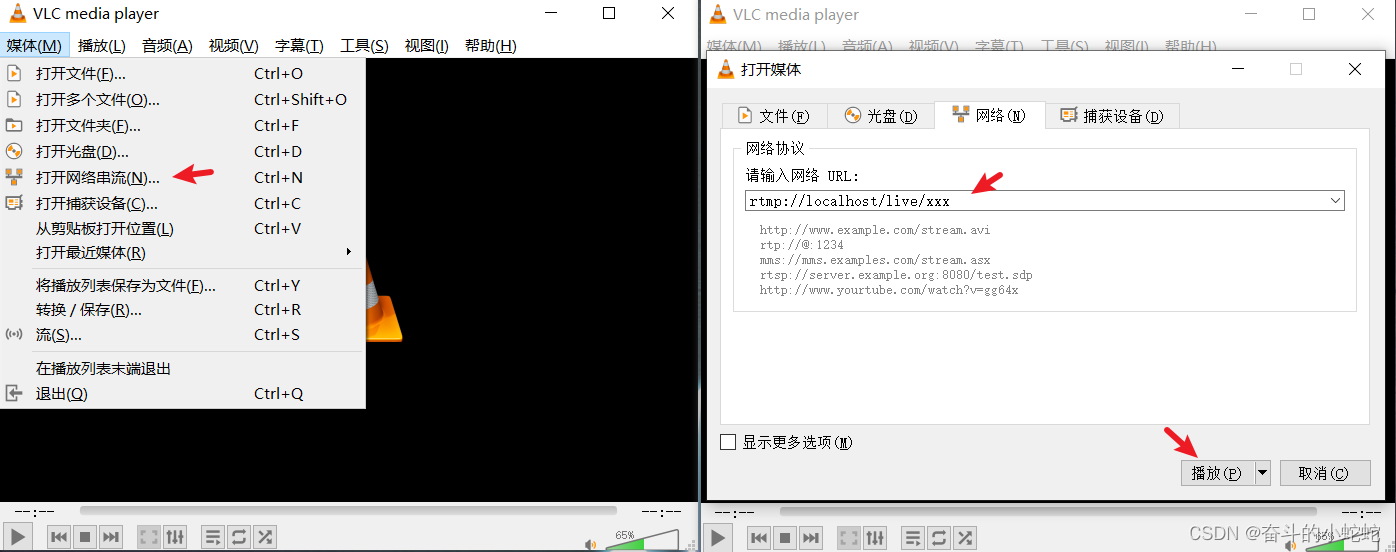阅读量:6
一、环境和工具
- ffmpeg version 5.1.2 (可用最新的) 下载地址 Builds - CODEX FFMPEG @ gyan.dev
- nginx 1.7.11.3 Gryphon.zip 下载链接 http://nginx-win.ecsds.eu/download/nginx 1.7.11.3 Gryphon.zip
- nginx-rtmp-module 下载地址 GitHub - arut/nginx-rtmp-module: NGINX-based Media Streaming Server
二、部署
- ffmpeg(环境变量配置,自行百度)
- 解压 nginx 1.7.11.3 Gryphon.zip 修改文件名为 nginx-1.7.11.3-Gryphon
- 解压 nginx-rtmp-module 将其放入 nginx-1.7.11.3-Gryphon 目录下
- 在目录 nginx-1.7.11.3-Gryphon\conf\ 文件夹下修改 nginx-win.conf 配置文件
#添加如下代码 rtmp { server { listen 1935; chunk_size 4096; application live { live on; } } } - 如下是本人的nginx-win.conf 配置文件内容,可参考,也可直接复制粘贴
#user nobody; # multiple workers works ! worker_processes 2; #error_log logs/error.log; #error_log logs/error.log notice; #error_log logs/error.log info; #pid logs/nginx.pid; events { worker_connections 8192; # max value 32768, nginx recycling connections+registry optimization = # this.value * 20 = max concurrent connections currently tested with one worker # C1000K should be possible depending there is enough ram/cpu power # multi_accept on; } rtmp { server { listen 1935; chunk_size 4096; application live { live on; } } } http { #include /nginx/conf/naxsi_core.rules; include mime.types; default_type application/octet-stream; #log_format main '$remote_addr:$remote_port - $remote_user [$time_local] "$request" ' # '$status $body_bytes_sent "$http_referer" ' # '"$http_user_agent" "$http_x_forwarded_for"'; #access_log logs/access.log main; # # loadbalancing PHP # upstream myLoadBalancer { # server 127.0.0.1:9001 weight=1 fail_timeout=5; # server 127.0.0.1:9002 weight=1 fail_timeout=5; # server 127.0.0.1:9003 weight=1 fail_timeout=5; # server 127.0.0.1:9004 weight=1 fail_timeout=5; # server 127.0.0.1:9005 weight=1 fail_timeout=5; # server 127.0.0.1:9006 weight=1 fail_timeout=5; # server 127.0.0.1:9007 weight=1 fail_timeout=5; # server 127.0.0.1:9008 weight=1 fail_timeout=5; # server 127.0.0.1:9009 weight=1 fail_timeout=5; # server 127.0.0.1:9010 weight=1 fail_timeout=5; # least_conn; # } sendfile off; #tcp_nopush on; server_names_hash_bucket_size 128; ## Start: Timeouts ## client_body_timeout 10; client_header_timeout 10; keepalive_timeout 30; send_timeout 10; keepalive_requests 10; ## End: Timeouts ## #gzip on; server { listen 80; server_name localhost; #charset koi8-r; #access_log logs/host.access.log main; ## Caching Static Files, put before first location #location ~* \.(jpg|jpeg|png|gif|ico|css|js)$ { # expires 14d; # add_header Vary Accept-Encoding; #} # For Naxsi remove the single # line for learn mode, or the ## lines for full WAF mode location / { #include /nginx/conf/mysite.rules; # see also http block naxsi include line ##SecRulesEnabled; ##DeniedUrl "/RequestDenied"; ##CheckRule "$SQL >= 8" BLOCK; ##CheckRule "$RFI >= 8" BLOCK; ##CheckRule "$TRAVERSAL >= 4" BLOCK; ##CheckRule "$XSS >= 8" BLOCK; root html; index index.html index.htm; } # For Naxsi remove the ## lines for full WAF mode, redirect location block used by naxsi ##location /RequestDenied { ## return 412; ##} ## Lua examples ! # location /robots.txt { # rewrite_by_lua ' # if ngx.var.http_host ~= "localhost" then # return ngx.exec("/robots_disallow.txt"); # end # '; # } #error_page 404 /404.html; # redirect server error pages to the static page /50x.html # error_page 500 502 503 504 /50x.html; location = /50x.html { root html; } # proxy the PHP scripts to Apache listening on 127.0.0.1:80 # #location ~ \.php$ { # proxy_pass http://127.0.0.1; #} # pass the PHP scripts to FastCGI server listening on 127.0.0.1:9000 # #location ~ \.php$ { # root html; # fastcgi_pass 127.0.0.1:9000; # single backend process # fastcgi_pass myLoadBalancer; # or multiple, see example above # fastcgi_index index.php; # fastcgi_param SCRIPT_FILENAME $document_root$fastcgi_script_name; # include fastcgi_params; #} # deny access to .htaccess files, if Apache's document root # concurs with nginx's one # #location ~ /\.ht { # deny all; #} } # another virtual host using mix of IP-, name-, and port-based configuration # #server { # listen 8000; # listen somename:8080; # server_name somename alias another.alias; # location / { # root html; # index index.html index.htm; # } #} # HTTPS server # #server { # listen 443 ssl spdy; # server_name localhost; # ssl on; # ssl_certificate cert.pem; # ssl_certificate_key cert.key; # ssl_session_timeout 5m; # ssl_prefer_server_ciphers On; # ssl_protocols TLSv1 TLSv1.1 TLSv1.2; # ssl_ciphers ECDH+AESGCM:ECDH+AES256:ECDH+AES128:ECDH+3DES:RSA+AESGCM:RSA+AES:RSA+3DES:!aNULL:!eNULL:!MD5:!DSS:!EXP:!ADH:!LOW:!MEDIUM; # location / { # root html; # index index.html index.htm; # } #} } 三、测试nginx
在 nginx-1.7.11.3-Gryphon 文件下 cmd 启动 nginx 指令
nginx.exe -c conf\nginx-win.conf关闭 nginx 指令
taskkill /f /t /im nginx.exe默认80端口,启动后在浏览器访问127.0.0.1,看到欢迎页面则启动成功
四、利用FFmpeg将rtsp转rtmp
- 转换指令
ffmpeg -i "rtsp://..." -c:v libx264 -c:a aac -f flv -tune zerolatency -g 30 -crf 20 -preset ultrafast "rtmp://localhost/live/{此处自定义}"本人场景是摄像头录制,此处可更换为视频文件、本机摄像头等录制设备。
五、VLC查看效果
- 将转换的 rtmp://127.0.0.1/live/xxx 复制到如下所示:

即可看到视频效果,延迟大概在5s左右
